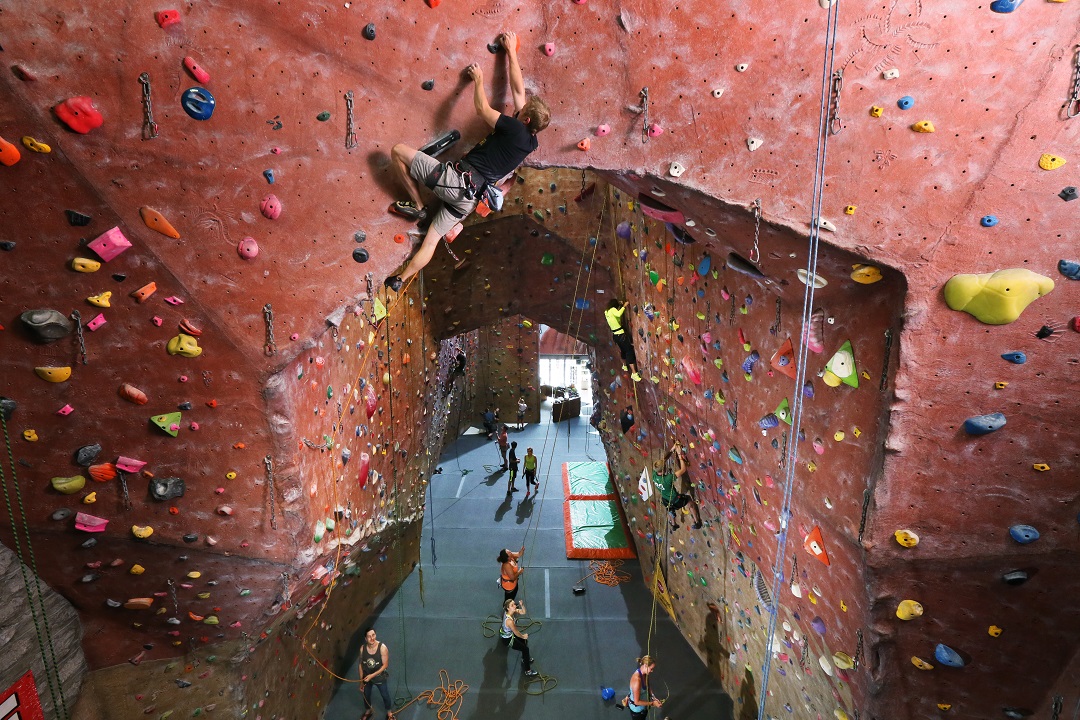A lot has changed in the world of climbing and bouldering over the last 25 years. While sport-defining gear such as the Kernmantle rope and sticky rubber shoes were inventions of the 1970s, the sport’s more recent evolution has no relation to advancements in equipment. Instead, the most obvious shift lies within the quantifiable: a rippling surge of new climbers, female climbers, and indoor climbing gyms.
Last year, more than 9.5 million people climbed at least once, according to the Outdoor Industry Association. Nearly half said they climbed or bouldered in a gym. It’s no wonder the commercial climbing gym industry saw its most successful year in 2018, according to the Climbing Business Journal.
Currently, St. Louis is home to four commercial rock-climbing gyms, a number that has quadrupled since 2001, when one husband-and-wife team made their St. Louis debut.
In the Beginning
Just a few years after the country’s first indoor rock-climbing gym opened in Seattle in 1987, Chris and Pam Schmick purchased their own climbing gym 2,000 miles away in rural Peru, Illinois. The newlywed, climbing-crazed couple bought Upper Limits in 1994 with a loan from his grandmother.
“I was psyched on rock climbing,” said Chris. “I mean really psyched. Take the most motivated climber you know, and I was 10 times worse. It was pretty much all I did. If it was cold, I’d boulder. If it was super cold, I’d ice climb. If I wanted adventure, it was big wall climbing. So, I was going to make buying the gym happen.”
The first Upper Limits gym was a converted racquetball court where outdoor climbers would train indoors, the standard modus operandi for climbing gyms of the ’80s and ’90s. Soon, they traded in their small, unassuming space for a long-abandoned grain silo in Bloomington, Illinois, a move only a visionary could deem an upgrade.
“I was 25 years old and didn’t know any better,” Chris said. “I remember some of my buddies saying, ‘what are you doing?’”
Buckets full of rotten, putrid soybeans were hauled out. Rusty machinery and scrap metal were laboriously dismantled and disposed of piece by piece. Chris and his friends lugged power washers 65 feet up to clean the silos before painstakingly drilling thousands of quarter-inch holes into the concrete walls.

Construction of Upper Limits Bloomington (Illinois) took six months of taxing, DIY labor.
Within six months, the upgrade was realized, and the gym opened. Since then, it has been named one of the “seven most innovative gyms in the world” by Smithsonian magazine.
Having conquered the grain silo, Chris and his wife took their show on the road, opening a downtown St. Louis gym in 2001. Rather than decomposing organics, the St. Louis challenge proved to be a lack of vertically suited buildings. After purchasing an industrial warehouse in Maryland Heights, Chris doubled its ceiling height to 45 feet for their third gym, which opened in 2011. Five years later, the Schmicks added a fourth, suburban gym in Chesterfield, which is marked by its prominent 7,000-square-foot, top-out boulder.
Then and Now
The stereotypical climber and the experience that is indoor rock climbing have changed significantly. Gone are the days when the indoor gym was the singularly purposed off-season training grounds for the sport’s super psyched. Today, a more diverse group of enthusiasts step into colorfully welcoming venues designed for every age and skill level. Many may never even step hand or foot onto real rock, which is a considerable deviation.
“I think the biggest change is demographics. There are way more women climbing than when we first opened. When we first opened, the only girls were the climbers’ girlfriends,” Chris said. “There’s also more middle-age climbers now, and it’s always fun to see people in their 80s who still climb on a regular basis. It really is a lifetime sport. Climbing competitions have changed a lot, too. When we first opened the gym in Bloomington, we had a regional comp with about 20 to 40 kids. Now, there are more like 400 or 500 kids at a lot of climbing comps.”
With rock climbing’s Olympic debut on the horizon and a number of climbing-related feats and features hitting the mainstream, the sport’s popularity shows no signs of slowing. As many new gyms are slated to open nationwide this year, Upper Limits celebrates a journey that is 25 years in the making.
Author: Corrie Hendrix Gambill is a regular contributor to Terrain Magazine.
Featured Image: Upper Limits Downtown in St. Louis has two tall arches and designated bouldering areas.


Leave A Comment